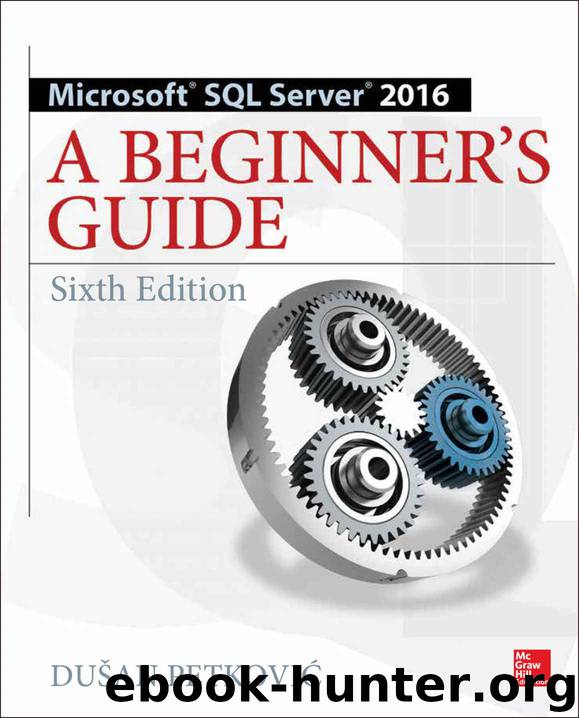Microsoft SQL Server 2016: A Beginner's Guide, Sixth Edition by Dusan Petkovic

Author:Dusan Petkovic [Petkovic, Dusan]
Language: eng
Format: azw3
Publisher: McGraw-Hill Education
Published: 2016-10-13T16:00:00+00:00
RAID 0 specifies disk striping without parity. Using RAID 0, the data is written across several disk drives in order to allow data access more readily, and all read and write operations can be speeded up. For this reason, RAID 0 is the fastest RAID configuration. The disadvantage of disk striping is that it does not offer fault tolerance at all. This means that if one disk fails, all the data on that array become inaccessible.
RAID 1 (Mirroring)
RAID 1 is the special form of disk striping that uses the space on a disk drive to maintain a duplicate copy of all files. Therefore, RAID 1, which specifies disk mirroring, protects data against media failure by maintaining a copy of the database (or a part of it) on another disk. If there is a drive loss with RAID 1 in place, the files for the lost drive can be rebuilt by replacing the failed drive and rebuilding the damaged files. The hardware configurations of RAID 1 are more expensive, but they provide additional speed. (Also, hardware configurations of RAID 1 implement some caching options that provide better throughput.) The advantage of the Windows solution for RAID 1 is that it can be configured to mirror disk partitions, while the hardware solutions are usually implemented on the entire disk.
In contrast to RAID 0, RAID 1 is much slower, but the reliability is higher. Also, RAID 1 costs much more than RAID 0 because each mirrored disk drive must be doubled. It can sustain at least one failed drive and may be able to survive failure of up to half the drives in the set of mirrored disks without forcing the system administrator to shut down the server and recover from file backup. (RAID 1 is the best-performing RAID option when fault tolerance is required.)
RAID 1 also has performance impacts in relation to read and write operations. When RAID 1 is used, write operations decrease performance, because each such operation costs two disk I/O operations, one to the original and one to the mirrored disk drive. On the other hand, RAID 1 increases performance of read operations, because the system will be able to read from either disk drive, depending on which one is least busy at the time.
Download
This site does not store any files on its server. We only index and link to content provided by other sites. Please contact the content providers to delete copyright contents if any and email us, we'll remove relevant links or contents immediately.
The Mikado Method by Ola Ellnestam Daniel Brolund(20604)
Hello! Python by Anthony Briggs(19900)
Secrets of the JavaScript Ninja by John Resig Bear Bibeault(18208)
Dependency Injection in .NET by Mark Seemann(18109)
The Well-Grounded Java Developer by Benjamin J. Evans Martijn Verburg(17576)
OCA Java SE 8 Programmer I Certification Guide by Mala Gupta(17422)
Kotlin in Action by Dmitry Jemerov(17185)
Adobe Camera Raw For Digital Photographers Only by Rob Sheppard(16934)
Algorithms of the Intelligent Web by Haralambos Marmanis;Dmitry Babenko(16237)
Grails in Action by Glen Smith Peter Ledbrook(15390)
Test-Driven iOS Development with Swift 4 by Dominik Hauser(10393)
Becoming a Dynamics 365 Finance and Supply Chain Solution Architect by Brent Dawson(8056)
Microservices with Go by Alexander Shuiskov(7820)
Practical Design Patterns for Java Developers by Miroslav Wengner(7721)
Test Automation Engineering Handbook by Manikandan Sambamurthy(7672)
Angular Projects - Third Edition by Aristeidis Bampakos(7160)
The Art of Crafting User Stories by The Art of Crafting User Stories(6611)
NetSuite for Consultants - Second Edition by Peter Ries(6533)
Demystifying Cryptography with OpenSSL 3.0 by Alexei Khlebnikov(6305)
